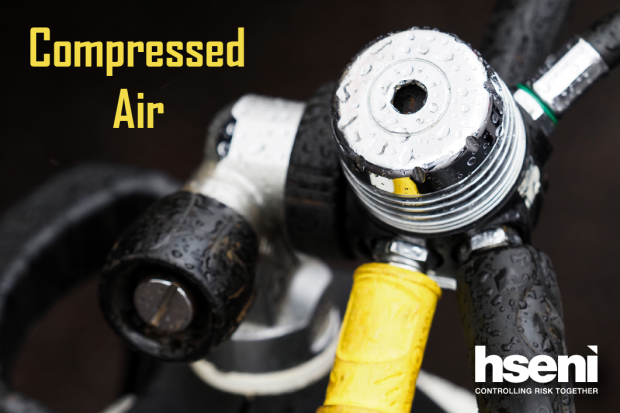Working in compressed air
When working in an environment under compressed air, employers must take all reasonably practicable steps to minimise the number and severity of exposures, but also to adopt exposure techniques which minimise the overall health risk to those undertaking the work.

What are the health risks associated with working in compressed air?
The three most common occupational ill-health conditions which can be brought about by working in compressed air are:
Decompression Sickness
This acute ill-health condition presents as pains around the joints (often referred to as Type 1 Decompression Sickness or when less severe "The Bends" or "Niggles"). In rare cases, it can present as a more serious and potentially life-threatening condition affecting the central nervous system (referred to as Type 2 Decompression Sickness).
Barotrauma
This ill-health condition can occur when direct damage is caused to the air containing cavities in the body, mainly the lungs, ears, and sinuses, due to a change in surrounding atmospheric pressure.
Dysbaric Osteonecrosis (DON)
Dysbaric Osteonecrosis (DON) - is caused by prolonged or closely repeated exposures to increased pressure (typically in people working in compressed air and in deep commercial rather than recreational divers). It is a long-term, chronic condition leading to deterioration of the shoulder and hip surfaces, resulting in severe pain and disability.
Most employees will never be involved in processes that require them to work in compressed air, however there are specialised industries that do involve this type of work which include:
- tunnelling
- diving
- pipe-jacking
- shaft sinking
- Caisson-making operations.
What does the law require?
Under the Health and Safety at Work (Northern Ireland) Order 1978, employers have a responsibility to ensure the health as well as the safety of their employees and others. This responsibility is reinforced by regulations.
The Diving at Work Regulations (Northern Ireland) 2005 provide a framework for the management of health and safety risks applicable to diving at work.
The Work in Compressed Air Regulations (Northern Ireland) 2004 provide a framework for the management of health and safety risks associated with work in compressed air applicable to construction. The principal contractor must appoint a competent compressed air contractor.
The Work in Compressed Air Regulations (Northern Ireland) 2004 apply to all compressed air work in construction irrespective of air pressure and address matters relating to:
- the appointment of competent persons to carry out various defined roles
- notification of the work to HSENI (at least 14 days before the work commences)
- safe systems of work including supervision arrangements
- provision and maintenance of suitable plant and equipment
- provision of adequate medical surveillance and maintenance of employee health records
- compression and decompression procedures (in accordance with any HSENI approved procedures)
- medical facilities and treatment
- emergency arrangements
- fire precautions
- provision of adequate information, instruction and training
- fitness for work
- welfare arrangements
The many duties applied on the compressed air contractor in charge of compressed air operations is reflective of the practical operation of the industry and gives recognition to the contractor in charge as being best placed to manage and control the health and safety risks associated with the compressed air operations. In 2001, a requirement for oxygen breathing during decompression was introduced.
Due to the number of people involved in construction work, The Construction (Design and Management) Regulations (Northern Ireland) 2016 also apply to compressed air projects. For many projects, the compressed air contractor will be the principal contractor under these Regulations.
Medical surveillance
The Work in Compressed Air Regulations (Northern Ireland) 2004 also requires the appointment of a Contract Medical Adviser to provide occupational health advice on all aspects of the work in compressed air.
Adequate medical surveillance, carried out by an appointed doctor or employment medical adviser, must be provided to all employees who work in compressed air. Where an employee is to be assigned to work in compressed air, the medical surveillance is required to be provided before they start the work. Medical surveillance will include examinations at intervals recommended by the appointed doctor or employment medical adviser but will not extend further than 12 months.
Regardless of medical surveillance, employers must ensure that employees do not work in compressed air if they have any medical conditions that would put them at risk. Likewise, employees must inform their employer of any applicable medical conditions they may have.
Medical treatment
Adequate facilities must be provided and maintained for the treatment of people working in compressed air or who have worked in compressed air within the preceding 24 hours.
Work undertaken at a pressure of 0.7 bar or above, requires:
- a medical lock
- a person competent to operate that lock
- a person competent to provide medical assistance in respect of any condition arising from working in compressed air (who may also be the person operating the lock)
Work undertaken at a pressure of 1.0 bar or above, requires:
- a medical lock
- the presence of a person competent both to operate that lock and to provide medical assistance should any condition arising from such work.
Legislation
- Health and Safety at Work (Northern Ireland) Order 1978 - (legislation.gov.uk)
- The Construction (Design and Management) Regulations (Northern Ireland) 2016 - (legislation.gov.uk)
- The Diving at Work Regulations (Northern Ireland) 2005 - (legislation.gov.uk)
- Work in Compressed Air Regulations (Northern Ireland) 2004 - (legislation.gov.uk)
Resources
- Compressed air safety (HSG39) - (hse.gov.uk)
- Managing health and safety in construction - Construction (Design and Management) Regulations 2015: Guidance on regulations (L153) - (hse.gov.uk)
- Workplace Health Topic Page
- Workplace Health Campaign Posters
The HSE publication “A guide to the Work in Compressed Air Regulations” has been withdrawn. However, the Work in Compressed Air Regulations remain unchanged. Industry guidance on the Regulations can be found on the website of the British Tunnelling Society.